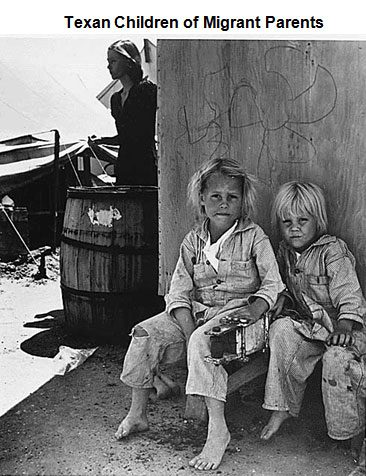
Source: Children of migrant parents, Dorothea Lange, Texas Parks and Wildlife department
At first, Texas did not feel the economic strain of the Great Depression as much as other parts of the United Sates. Since more Texans had invested in their farms and ranches, rather than in the stock market, the stock market crash of 1929 did not affect as many people and businesses.
The unemployment rate in Texas was relatively low compared to that of the rest of the nation. Texans had an advantage over other states. Most Texans had a vast amount of land that allowed owners to grow food to feed their families, and since they were not wealthy, they were able to adjust easily to the economic changes that the Great Depression brought.

Source: Children of migrant parents, Dorothea Lange, Texas Parks and Wildlife department
Soon, however, Texans found themselves in the same condition as the rest of the country. People began to lose jobs and eventually ran out of money. The state government also experienced a drain on the state treasury. Many Texans lost their homes and had to migrate westward as many Americans did during this time.
The children, pictured here, were children of young migrant workers from Texas. This photo was taken in California. The state of California was a popular location for people to migrate. The weather and fertile soil in California attracted people looking for jobs and opportunities for farming.
Let’s think about this: Why do you think this family migrated from Texas to California?

Another setback to Texas’s economy during the Great Depression was a dust storm that hit the Texas Panhandle in 1935. A series of black blizzards descended upon Texas on April 14, 1935, also called “Black Sunday.” On this day, winds moving at 60 miles per hour, carrying thick black dust, rolled through the Texas Panhandle. The Dust Bowl had come to Texas.
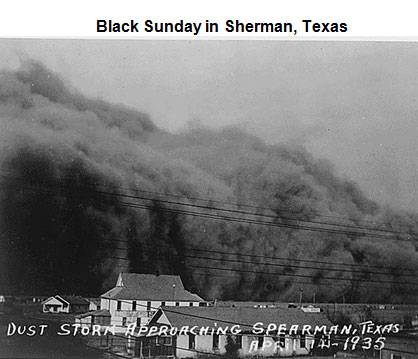
Source: 27-0724, National Oceanic
Click on the link below to watch a video about black blizzards, and then answer the following questions in your notes.
Interactive popup. Assistance may be required.
The Dust Bowl originated in 1931.
Interactive popup. Assistance may be required.
The drought in 1931, accompanied by the absence of native grasses in the Great Plains encouraged the conditions that led to the Dust Bowl.
Interactive popup. Assistance may be required.
Kansas, Colorado, Oklahoma, Nebraska, Texas, and New Mexico were impacted by the Dust Bowl.
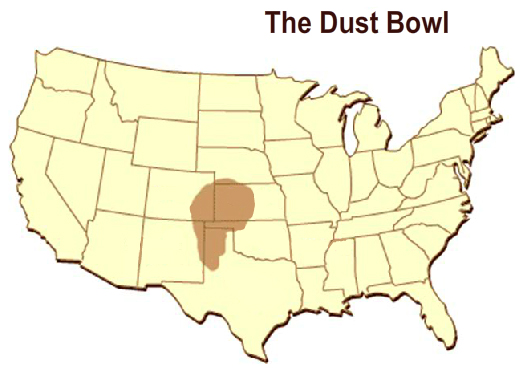
Source: Dust Bowl Map, University of Illinois at Urbana
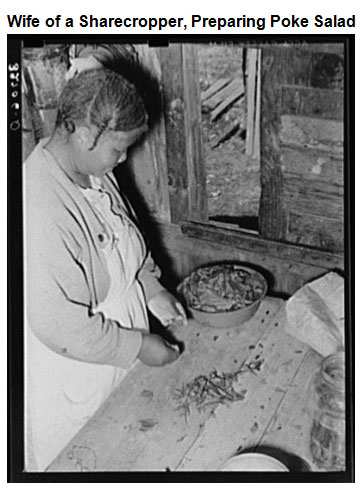
Source: 8b2134r, Library of Congress
While the Great Depression caused an economic disaster in Texas, this crisis also caused social upheaval in the state. Women and minorities in Texas felt the effects of the Great Depression the hardest. During the stressful times of the Great Depression, many women and minorities lost their jobs to white men.
As Texans looked for work, white men were offered employment before anyone else. African-American men were consistently considered last. Married women lost their jobs if their husbands were employed, and minorities were displaced when white men were offered employment.
In response to the discrimination that they faced, minority groups in Texas worked to overcome these obstacles during the Great Depression.
African Americans in Texas faced harsh poverty during the Great Depression. The woman, pictured here, is making “poke salad,” a salad made from wild greens and weeds, near Marshall, Texas.
African-American women often became heads of their households, since most African-American men had to leave home to look for work. The National Association for the Advancement of Colored People (NAACP) worked to organize people to fight discrimination against African Americans in Texas.
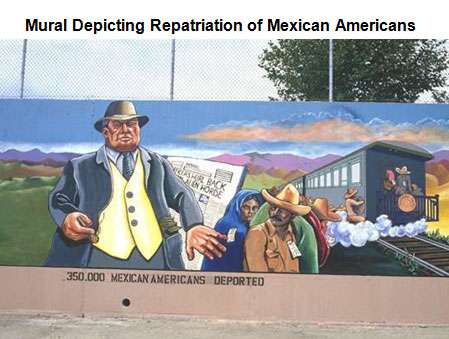
Source: Mexican Americans deported, Digital History, The University of Houston
The competition for jobs was especially hard for Mexican Americans. In Texas and other states that border Mexico, Mexicans and Mexican Americans had to face an additional threat: deportation. As unemployment permeated the United States, hostility toward immigrant workers grew. According to the Library of Congress, the government began a program of repatriation to Mexico. Immigrants were offered free train rides to Mexico, and some went voluntarily, but many were either tricked or coerced into repatriation, and some U.S. citizens were deported simply on suspicion of being Mexican. Eventually, hundreds of thousands of Mexican immigrants, especially farmworkers, were sent out of the country during the 1930s.
The mural, pictured here, depicts Mexican repatriation. The League of United Latin American Citizens (LULAC) was formed during this time. The organization’s main function was to help secure the civil rights of Mexican Americans.
Read this excerpt from Houston and The Great Depression.

Source: Houston Downtown, Texas Gen Web Project
Analyzing the excerpt: Why did Houstonians do better than most Texans during the Great Depression? Was Houston able to maintain its steady economy during the Depression? How did African Americans fare in Houston during the Great Depression?

The social changes in Texas also impacted the political changes in Texas during the Great Depression. Disappointed with the Republican’s president, Herbert Hoover, inability to help the nation recover from the Great Depression, many Hispanic Americans and African Americans joined the Democratic Party. In 1932, over 90 percent of Texans voted for Franklin Delano Roosevelt, who became the 32nd president of the United States. John Nance Garner, a Texan, was elected vice president.
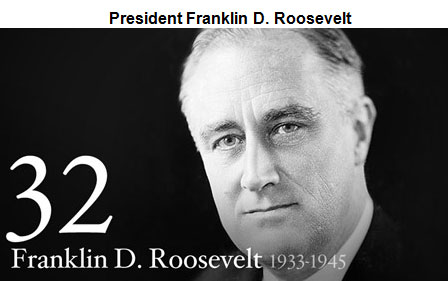
Source: 32fr header sm, The White House
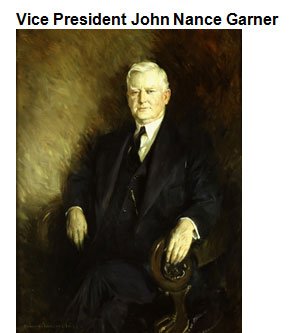
Source: John Nance Garner, Howard Chandler Christy, United States Senate
According to the National Archives, Roosevelt planned to address the economic issues with the 3 R’s: relief for the needy, economic recovery, and financial reform. Roosevelt used his first hundred days to fulfill his campaign promise to give Americans a “New Deal.”
Click on the images below to learn more about the New Deal programs benefitted by Texas.
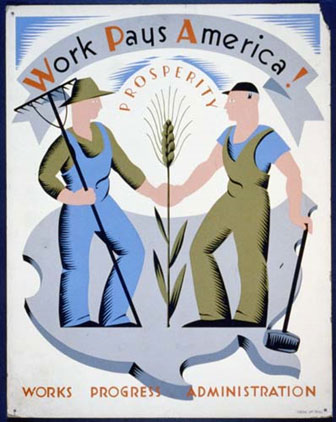
Source: WPA Poster, New Deal Texas, Texas Parks and Wildlife Department
Professionals like architects, artists, and teachers found themselves unemployed. The Works Progress Administration (WPA) provided employment opportunities to both skilled and unskilled laborers. Workers worked on projects to help beautify their communities.
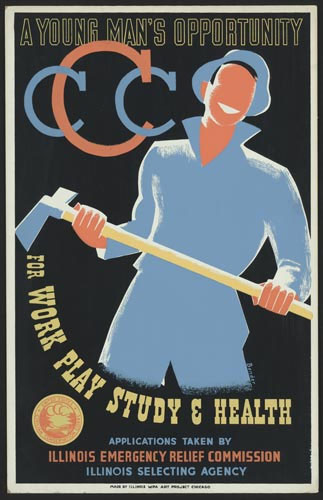
Source: CCC Poster, New Deal Texas, Texas Parks and Wildlife
In Texas, the Civilian Conservation Corps paid young men to work on various infrastructures throughout Texas. The CCC hired young, unmarried men between the ages of 18 and 25. Most were unskilled laborers whose families were unemployed; a large portion of their pay went back home to their families. The young men were provided with food, clothing, and shelter.
The Agricultural Adjustment Act (AAA) was a very important New Deal program for Texas. This program was designed to adjust the production of certain agricultural products, such as cotton, wheat, and dairy products. The program limited the amount that farmers could produce, in an effort to stop farmers from producing too much and ruining the soil. Farmers who participated in the program received relief or money to supplement their income.
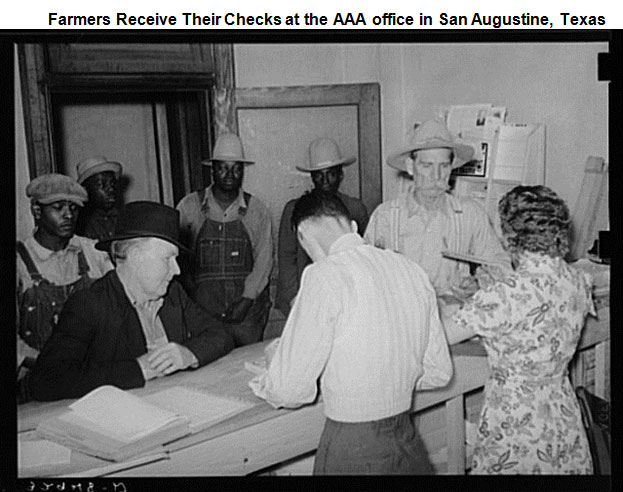
Source: LBJLeader, United States Senate
Let’s think about this: Why do you think the government wanted to limit the amount of agricultural products in Texas?

There were many Texans who played a major role in helping the United States (and Texas) recover from the Great Depression.
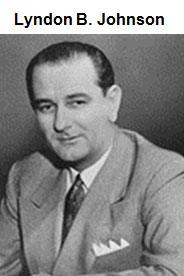
Source: LBJLeader, United States Senate
During the Great Depression, Lyndon Baines Johnson, secretary to U.S. Representative Richard Kleberg, was appointed director of National Youth Administration for Texas. This New Deal program aimed to help young adults get jobs and an education. Johnson later became a U.S. Representative, a U.S. Senator, and eventually the President of the United States.
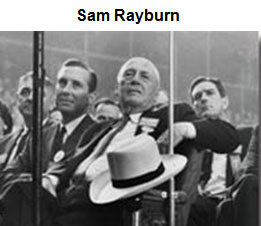
Source: di00495, Briscoe Center for American History, University of Texas
U.S. Representative, Sam Rayburn served in the U.S. Congress for nearly 50 years. Rayburn supported Roosevelt and most of the New Deal legislation. Rayburn was active in creating several of the New Deal programs.
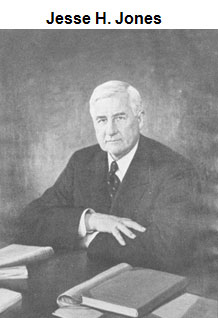
Source: Jesse Holman Jones perso174, Wikipedia
Jesse H. Jones was a successful entrepreneur from Houston. During the Great Depression, Jones led the Reconstruction Finance Corporation, a federal agency that helped the U.S. economy rebound from the Great Depression. During the Depression, Jones helped transform Houston into a successful site for international commerce. Under his leadership, no banks in Houston failed during the Great Depression.